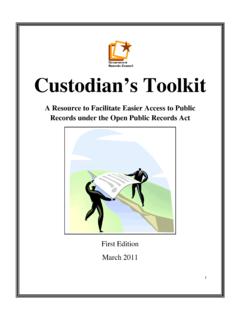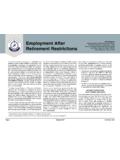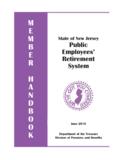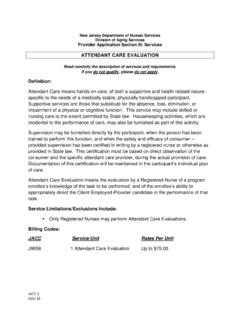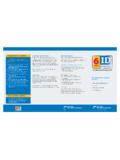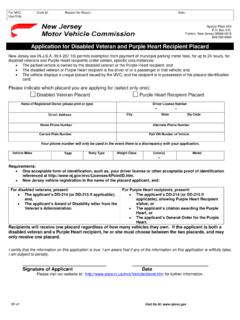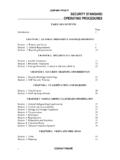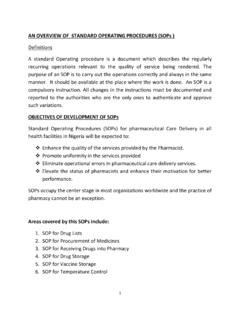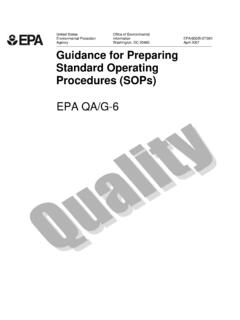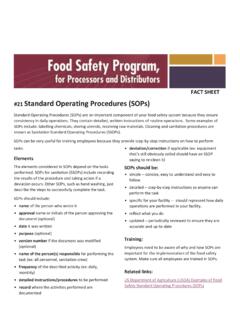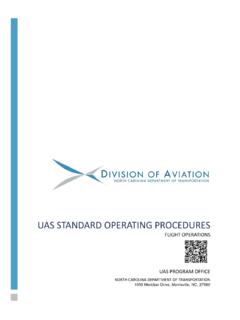Transcription of HACCP-Based Standard Operating Procedures (SOPs)
1 Form #373 December 2017 HACCP-Based Standard Operating Procedures DISTRICT: _____ SCHOOL: _____ HACCP-Based sops 1 Table of Contents 2 Key Points & 3 Facility 4 Seven Steps/Components of Comprehensive Food Safety Program .. 5 STEPS #1, #4, #5, #6, #7: HACCP-Based Standard Operating Procedures 1. Assembling a Body Fluid Cleanup 6 2. Cleaning and Disinfecting Body Fluid 9 3. Cleaning and Sanitizing Food Contact Surfaces .. 14 4. Communicating During a Foodborne Illness 18 5. Communicating Norovirus Prevention 20 6. Controlling Time and Temperature During Preparation .. 21 7. Cooking Time/Temperature Control for Safety Foods.
2 23 8. Cooling Time/Temperature Control for Safety 25 9. Date Marking and Ready-to-Eat, Time/Temperature Control .. 27 10. Handling a Food Recall .. 29 11. Hot and Cold Holding for Time/Temperature Control for Safety 31 12. Personal Hygiene .. 34 13. Preventing Contamination at Food Bars .. 36 14. Preventing Cross Contamination During Storage and Preparation .. 38 15. Receiving Deliveries .. 40 16. Reheating Time/Temperature Control for Safety 43 17. Serving Food .. 45 18. Serving Safe Food to Students with Food Allergies .. 47 19. Storing and Using Poisonous or Toxic Chemicals .. 49 20. Transporting Food to Remote Sites (Satellite Kitchens) .. 51 21. Using and Calibrating Thermometers.
3 54 22. Using Suitable Utensils When Handling Ready-to-Eat Foods .. 57 23. Using Time Alone as a Public Health Control to Limit 59 24. Washing Fruits and Vegetables .. 61 25. Washing Hands .. 63 65 81 HACCP-Based sops 2 Overview of the Process Approach to HACCP HACCP is a systematic approach to construct a food safety program designed to reduce the risk of foodborne hazards by focusing on each step of the food preparation process from receiving to service. As the USDA has recommended the our School District uses the Process Approach to HACCP because it gives schools flexibility to create a food safety program specific to their food service operation.
4 The Process Approach groups food preparation into three broad categories based on how many times each menu item moves through the temperature danger zone. Serving safe food is a critical responsibility for school nutrition staff in our School District and a key aspect of our healthy school environment. Keeping foods safe is also a vital part of healthy eating and a recommendation of the Dietary Guidelines for Americans. Our HACCP-Based food safety program will help us ensure the safety of the school meals served to children in our School Nutrition Program. Food Process These are the preparation categories in the Process Approach to HACCP: Process #1 / No Cook, food items meant to be kept cold from preparation through service Process #2 / Same Day Service, food items meant to be prepared hot and served hot the same day Process #3 / Complex Food Preparation, food items meant to be prepared hot and served cooled, or reheated.
5 Each menu item (recipe) is put into one of the three categories and then kept hot (or cold) while it is being stored, prepared, transported, held, and served. sops HACCP-Based sops include the following principles: Corrective Actions Monitoring Procedures Verification Procedures Record Keeping Procedures Your food safety program should be specific to meet the needs of each food production and school nutrition facility in your district. You may need to modify the sops and worksheets so they comply with your specific school, state and local requirements. The SFA s food safety program must include a written plan for each school in the SFA and be based on HACCP principles.
6 HACCP-Based sops 3 Food Safety Program . Key Points: Three main points are essential to our HACCP food safety program: basic facility sanitation, temperature control, and documented sops . 1. Our school nutrition staff will be sure that all of our food preparation areas are clean and sanitary, such as workers hands, utensils, and food contact surfaces and will avoid cross contamination. 2. Our school nutrition staff implements temperature control. Cold foods are kept cold and hot foods are kept hot. Foods are cooked to proper temperatures and held at proper temperatures. Temperatures are recorded. A basic, properly calibrated food thermometer (digital, dial or laser) is used to check for proper temperatures.
7 3. Our school nutrition staff uses sops as a reference to verify proper sanitation and the observance of proper temperatures, as well as other food safety aspects in our foodservice operation. Key Terms for HACCP: Hazard Analysis: Review of your food service operation to find areas where food safety problems might occur. Control Measures: Steps you take to reduce the likelihood of food contamination. Critical Control Points: Points in food preparation and processing where controlling a step (such as cooking) is essential to assure food safety. Critical Limits: The time and temperature ranges for food preparation and service (either cold or hot) that keep food safe.
8 Process Approach: A method of grouping menu items into one of three processes depending on the number of times the food goes through the temperature danger zone, which is between 41 F and 135 F (as stated in the FDA Code). Standard Operating Procedure (SOP): Written instructions for a food service task that reduces food safety hazards. HACCP-Based sops 4 FACILITY OVERVIEW This program was developed by _____, Foodservice Director. The program follows the USDA guidance on developing a food safety program based on the Process Approach to HACCP. All standards in this food safety program are based on recommendations in the Food Code and the New Jersey State Health Code Chapter XXIV.
9 School Building: _____ Ages: _____ Average Daily Funded Meal Participation: Breakfasts - _____ Lunches - _____ School Foodservice Staff: _____ Manager/Unit Leader/Lead Cook #_____ Staff Kitchen Equipment: Self-Prep (prepares meals on site) Central Kitchen (prepares; serves on site and transports to other sites) Satellite Kitchen (receives meals or food from a central or production kitchen) Vended Kitchen (receives meals from a contracted vendor or other district) Comments: HACCP-Based sops 5 Components of a Comprehensive Food Safety Program Directions: For each of your school nutrition programs complete the following information. Component Location Task Completed Date Step #1 Documented sops Step #2 Documented Process Approach: -Listed on No-Cook/Same Day/Complex Worksheets or Production Records Step #2 Standardized Recipes Step #3 Documented Critical Control Points & Critical Limits -Listed on Production Records and/or in Standardized Recipes Step #4 Monitoring -Listed on sops Step #5 Corrective Actions -Listed on sops Step #6 Record Keeping -Listed on sops Step #7 Verification -Review & Revise sops -Sign sops when Reviewed and/or Revised Ongoing Food Safety Training HACCP-Based sops 6 SOP #1 - Assembling a Body Fluid Cleanup Kit (Sample SOP) PURPOSE.
10 To prepare for incidents requiring cleaning and disinfecting of body fluids, including vomit, diarrhea, and blood. SCOPE: This procedure applies to school nutrition employees and/or custodial and maintenance staff involved in assembling a body fluid cleanup kit to use for a body fluid cleanup incident. KEY WORDS: Body Fluid Spill, Cleaning, Disinfecting, Body Fluid Cleanup Kit, Norovirus INSTRUCTIONS: 1. Purchase, and keep on hand at all times, sufficient quantities of the following items needed to assemble and immediately re-stock a Body Fluid Cleanup Kit: Ethanol based hand sanitizer (62% Ethanol, FDA compliant) Waterproof container sufficient in size to store personal protective and cleaning equipment Personal protective equipment (PPE): o 6-12 pairs of disposable, non-latex gloves.
